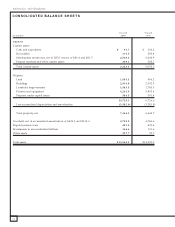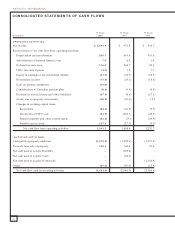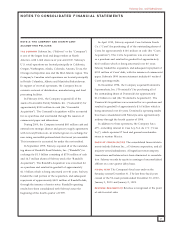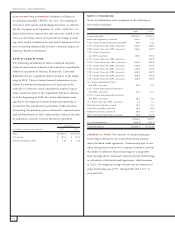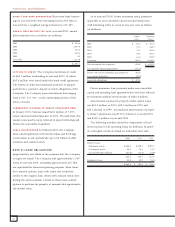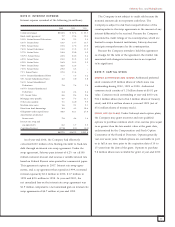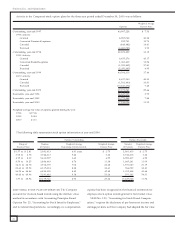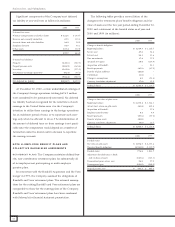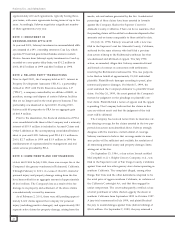Safeway 2000 Annual Report Download - page 36
Download and view the complete annual report
Please find page 36 of the 2000 Safeway annual report below. You can navigate through the pages in the report by either clicking on the pages listed below, or by using the keyword search tool below to find specific information within the annual report.
Safeway Inc. and Subsidiaries
34
SHORT-TERM BANK BORROWINGS Short-term bank borrow-
ings at year-end 2000 have remaining terms of 43 days or
less and have a weighted average interest rate of 7.18%.
ANNUAL DEBT MATURITIES As of year-end 2000, annual
debt maturities were as follows (in millions):
2001 $ 626.8
2002 3,103.6
2003 378.6
2004 698.6
2005 6.5
Thereafter 1,219.0
$ 6,033.1
LETTERS OF CREDIT The Company had letters of credit
of $89.7 million outstanding at year-end 2000, of which
$45.4 million were issued under the bank credit agreement.
The letters of credit are maintained primarily to support
performance, payment, deposit or surety obligations of the
Company. The Company pays commitment fees ranging
from 0.20% to 1.00% on the outstanding portion of the
letters of credit.
SUBSEQUENT ISSUANCE OF SENIOR UNSECURED DEBT
In January 2001, Safeway issued $600 million of 7.25%
senior unsecured debentures due in 2031. Proceeds from this
issuance were used to repay commercial paper borrowings and
finance the Genuardi’s Acquisition.
SHELF REGISTRATION In February 2001, the Company
filed a shelf registration with the Securities and Exchange
Commission to sell, periodically, up to $2 billion in debt
securities and common stock.
NOTE D: LEASE OBLIGATIONS
Approximately two-thirds of the premises that the Company
occupies are leased. The Company had approximately 1,500
leases at year-end 2000, including approximately 210 that
are capitalized for financial reporting purposes. Most leases
have renewal options, some with terms and conditions
similar to the original lease, others with reduced rental rates
during the option periods. Certain of these leases contain
options to purchase the property at amounts that approximate
fair market value.
As of year-end 2000, future minimum rental payments
applicable to non-cancelable capital and operating leases
with remaining terms in excess of one year were as follows
(in millions):
Capital Operating
Leases Leases
2001 $ 95.6 $ 336.4
2002 78.5 340.2
2003 74.1 325.0
2004 80.6 301.4
2005 63.6 290.9
Thereafter 501.6 2,649.6
Total minimum lease payments 894.0 $ 4,243.5
Less amounts representing interest (431.2)
Present value of net minimum lease payments 462.8
Less current obligations (47.0)
Long-term obligations $ 415.8
Future minimum lease payments under non-cancelable
capital and operating lease agreements have not been reduced
by minimum sublease rental income of $246.8 million.
Amortization expense for property under capital leases
was $43.9 million in 2000, $38.5 million in 1999 and
$22.3 million in 1998. Accumulated amortization of proper-
ty under capital leases was $132.2 million at year-end 2000
and $132.3 million at year-end 1999.
The following schedule shows the composition of total
rental expense for all operating leases (in millions). In gener-
al, contingent rentals are based on individual store sales.
2000 1999 1998
Property leases:
Minimum rentals $ 323.3 $ 280.3 $ 208.7
Contingent rentals 16.7 18.6 19.2
Less rentals from subleases (27.2) (13.2) (12.0)
312.8 285.7 215.9
Equipment leases 31.0 42.9 22.4
$ 343.8 $ 328.6 $ 238.3


